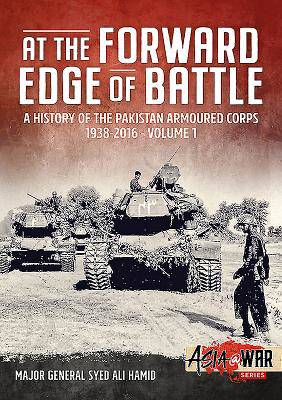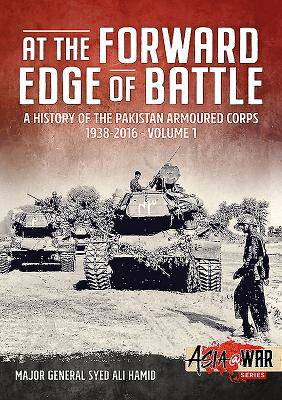
- Afhalen na 1 uur in een winkel met voorraad
- Gratis thuislevering in België vanaf € 30
- Ruim aanbod met 7 miljoen producten
- Afhalen na 1 uur in een winkel met voorraad
- Gratis thuislevering in België vanaf € 30
- Ruim aanbod met 7 miljoen producten
Zoeken
At the Forward Edge of Battle - A History of the Pakistan Armoured Corps 1938-2016
Volume 1
Syed Ali Hamid
€ 27,95
+ 55 punten
Uitvoering
Omschrijving
This is a well-researched and authoritative account by a military historian, Maj Gen Syed Ali Hamid. It embraces the evolution of the Pakistan Armoured Corps, including its culture, organization, doctrine, equipment, operational performance, overseas deployment, garrisons, personalities and a myriad of events that together portray what and why the corps is at this point in time. Beginning with the mechanization of the Indian cavalry in 1938, it spans nearly 95 years and chronicles the corps remarkable growth. It narrates how a redundant horse mounted force went through various stages of metamorphosis, surmounted the challenges of Independence and transformed from a small supporting arm into the mechanized spearhead of the Pakistan Army. Its richness lies in the portrayal the Muslim clans that form the rank and file of the Armoured Corps, as well as tracing the development of its officer corps from its genesis and onwards through the Second World War and leading onto post-Independence. This includes an assessment of many personalities who performed a leading role in the development of the corps. It also provides an interesting insight into the culture of the Pakistan Armoured Corps which is a unique blend of values and traditions inherited from its predecessor, with those of a post-Independence national army.
This highly informative book compliments publications on the Pakistan Army by elaborating on the role and structure of one of its principal arms. Since it covers in some detail the Pakistan-India conflicts, it also compliments books published by the Indian authors by presenting a view from 'the other side of the hill.' To place the evolution and development of the armored corps in context, the author has painstakingly researched and presented hitherto fragmented information on the Pakistan Army. Consequently the book also emerges as a work of value to an audience which is interested in how the Pakistan Army evolved and the milestones in its development.
Having served in the Pakistan Army for 50 years, the author has a unique insight into the evolution of the corps and is linked with its past through his father Maj Gen Syed Shahid Hamid who was commissioned from Sandhurst into the cavalry of British India in 1933. Shahid was one of the pioneers of the Pakistan Army and the author of several books on political and military history of the sub-continent. The publication is liberally illustrated with a large number of photographs, many of them unpublished, which makes for very interesting reading. There is also a liberal use of maps to support the text. For a serious student of the military history of the Pakistan-India Subcontinent, this book is a major scholarly work with footnotes / endnotes, a bibliography of ten pages of primary and secondary references, and two large indexes.
This highly informative book compliments publications on the Pakistan Army by elaborating on the role and structure of one of its principal arms. Since it covers in some detail the Pakistan-India conflicts, it also compliments books published by the Indian authors by presenting a view from 'the other side of the hill.' To place the evolution and development of the armored corps in context, the author has painstakingly researched and presented hitherto fragmented information on the Pakistan Army. Consequently the book also emerges as a work of value to an audience which is interested in how the Pakistan Army evolved and the milestones in its development.
Having served in the Pakistan Army for 50 years, the author has a unique insight into the evolution of the corps and is linked with its past through his father Maj Gen Syed Shahid Hamid who was commissioned from Sandhurst into the cavalry of British India in 1933. Shahid was one of the pioneers of the Pakistan Army and the author of several books on political and military history of the sub-continent. The publication is liberally illustrated with a large number of photographs, many of them unpublished, which makes for very interesting reading. There is also a liberal use of maps to support the text. For a serious student of the military history of the Pakistan-India Subcontinent, this book is a major scholarly work with footnotes / endnotes, a bibliography of ten pages of primary and secondary references, and two large indexes.
Specificaties
Betrokkenen
- Auteur(s):
- Uitgeverij:
Inhoud
- Aantal bladzijden:
- 96
- Taal:
- Engels
- Reeks:
Eigenschappen
- Productcode (EAN):
- 9781911628071
- Verschijningsdatum:
- 16/10/2019
- Uitvoering:
- Paperback
- Formaat:
- Trade paperback (VS)
- Afmetingen:
- 206 mm x 295 mm
- Gewicht:
- 362 g

Alleen bij Standaard Boekhandel
+ 55 punten op je klantenkaart van Standaard Boekhandel
Beoordelingen
We publiceren alleen reviews die voldoen aan de voorwaarden voor reviews. Bekijk onze voorwaarden voor reviews.











